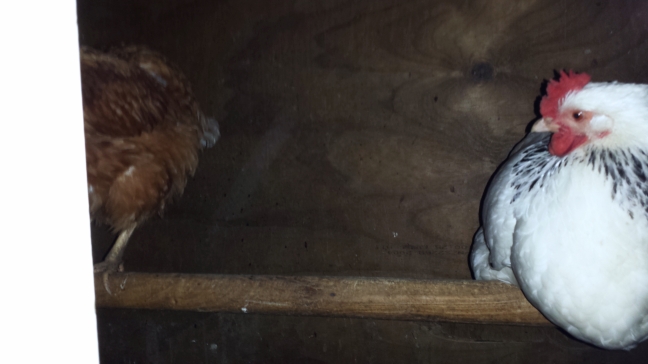 Chickens are naturally ground-dwelling prey animals and they have a lot of predators and not many defences against them. So they like it if they can have somewhere safe to perch out of the way of trouble. Chickens will perch on a tree branch quite happily during the day for a bit of a rest, but at night they need a proper perch inside their hen house.
Chickens are naturally ground-dwelling prey animals and they have a lot of predators and not many defences against them. So they like it if they can have somewhere safe to perch out of the way of trouble. Chickens will perch on a tree branch quite happily during the day for a bit of a rest, but at night they need a proper perch inside their hen house.
Right now it’s nearly the middle of winter and that means the days are short and the nights are long. And that means your chickens may be spending up to fourteen hours every night roosting on their perch. So it’s important to have a perch that’s comfortable. Maybe a perch is something you haven’t given a lot of thought to, but it’s just as important for a chicken to have a comfortable perch as it is to you to have a comfortable bed.
So what do we need to know about perches? How big should they be? How long? How many of them do you need? Where are you going to put them? What should you make them out of?
Most people make their perches out of wood, and that works pretty well for a perch. Metal can be very cold, although it’s easy to clean and look after, it’s not very comfortable for chickens. Plastic is very slippery and it’s hard for the chickens to stay comfortable for a long time trying to balance on a piece of slippery plastic. So, wood is readily available, easy to shape and mould and cut to the right size, and all around probably the most common thing used for perches.
So, how big should it be? Well if you can put your hands around it, it’s probably ok. You don’t want anything much smaller. Although the chickens will spend some time standing on their perch, with their feet wrapped around it, they’ll spend more of their time sitting, with their breastbone resting on the perch. So they need a relatively broad, flat surface to rest on during the night. So make sure it’s nice and wide.
How long should a perch be? Well that depends on how many chickens you have. Every chicken needs at least twenty centimetres, but I like to make sure than mine have got a good foot, thirty centimetres per chicken. Plenty of room for each bird to perch along it during the night, and maybe a bit of elbow room would be nice too, so allow plenty. Apart from anything else, I bet you end up with more chickens that you thought you were going to!
Having a perch that’s square on the end can be very useful, because it’s easy to attach and hold in place, but you want to make sure there are no sharp edges that will hurt the chickens while they’re resting on it during the night. So smooth it off and make it round. It doesn’t have to be as beautiful as a piece of furniture inside, but make sure it’s nice and smooth and comfortable.
Once you’ve finished making the surface of the perch nice and smooth, I suggest rubbing it with a bit of Neem Tree Oil. That will help keep any insects away and keep down any problem you have with red mites in your chicken coop.
Make sure that the perch is no more than about six hundred mm, i.e.a couple of feet, off the ground. Otherwise it’s too far, not for the chicken to jump up, but for the chicken to jump down again without hurting her feet.
And of course you need some room above the perch so the chickens don’t bump their heads on the roof. About half a metre, a couple of feet, should do it. If you find that you’ve succumbed to temptation and got more chickens than will fit on your perch, you can always add another one. Just make sure that there’s at least a foot between the two perches. Of course, more room is better.
Make sure that the perches are higher than the nest box, otherwise you’ll have chickens wanting to sleep in the nest box at night, and although they might think that seems cosy, they end up sleeping in a pile of manure, which is cold and damp and burns their skin. So the nesting box should be lower than the perch.
One of the things you need to be careful about is the possibility of red mites finding a home in your chicken run. And where they love best to live is underneath the perch where they can come out at night and nibble on your chickens’ feet. So I like to make sure that my perch is not attached permanently. It’s very easy just to flip it over and check for any red mites that might be living underneath.
And what if you don’t happen to have planned a handy perch rest about five hundred mils off the floor of the chicken house? Then you can just nail a piece of wood to the wall at just the right height, and it’s easy to check underneath your perch for mites at any time.
